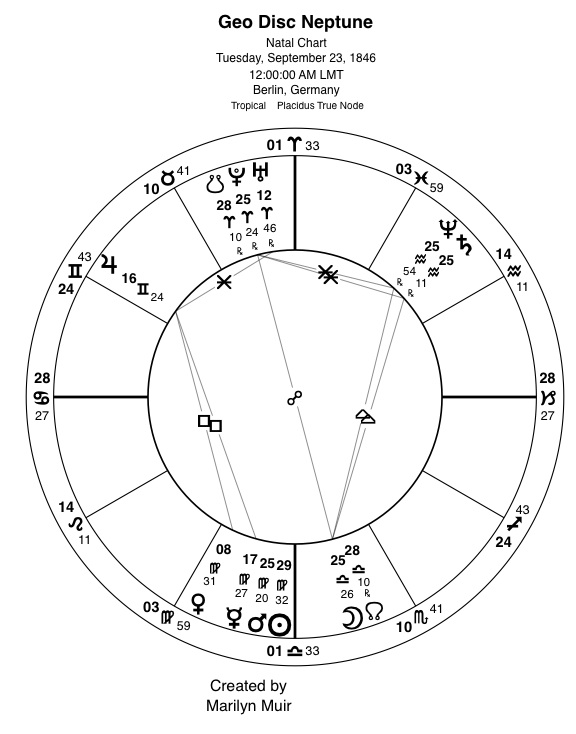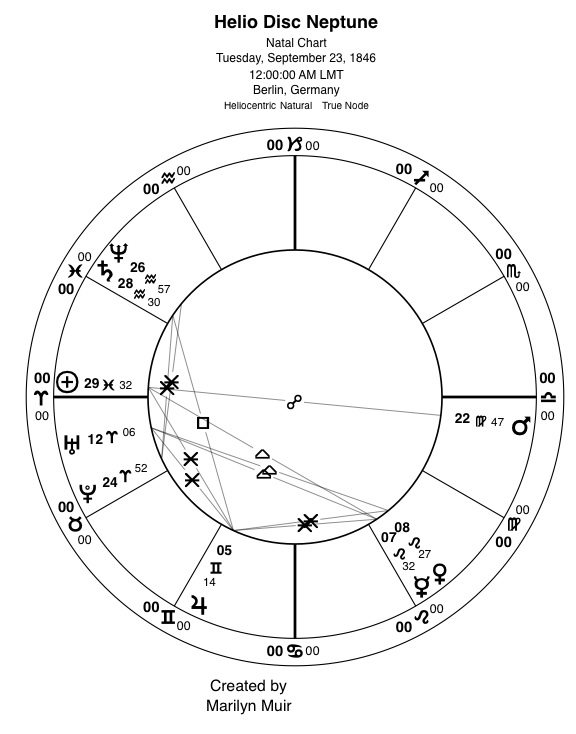by Marilyn Muir, LPMAFA

This work is licensed under a Creative Commons Attribution-NonCommercial-ShareAlike 4.0 International License.
Recently I saw multiple reports on the return of Neptune to its discovery position. I wanted to write about it, but the dates and positions were not making much sense to me. Not surprising since we are talking about Neptune. Yesterday I found out why the perceived position discrepancy was accurate. Let me see if I can explain it.
Discovery Uranus was discovered March 13, 1781. Due to discrepancies in the orbit of Uranus, astronomers became aware of the probability of another planet and began searching. It was found in his notes that Galileo had actually seen the planet twice with a primitive telescope on December 28, 1612 and January 6, 1613 and recorded it in his notes as an object on Jan 28, 1613, but he had not realized that the object was a planet. Neptune is so distant that it was not discovered through visual observation but through mathematical calculation, which was then supported by subsequent visual observation. Several different threads of investigation had occurred and the credit for discovery was very confusing. The bare bones fact is that Neptune became consciously “known” on September 23, 1846, very close to the location that was predicted by Astronomers John Couch Adams and Urbain Le Verrier in 1841. Most of the documents I have read set the discovery time at midnight, so that is the basis for the charts for this article rather than the traditional noonmark chart for unknown birth times. Heliocentric and geocentric charts are provided as is the link to the Neptune return diagram in the Hubble telescope article.
- Heliocentric Neptune at the moment of discovery was 26 Aqu 57.
- Geocentric Neptune at the moment of discovery was 25 Aqu 54 retrograde.
- Remember heliocentric (Sun in center of solar system) is reality.
- Geocentric (Earth in the center) is “apparent reality” based on our local perspective.
- There are no retrogrades heliocentrically; retrograde motion of the planets exists only in the geocentric perspective.

Geocentrically (our usual measure), 25 Aqu 54 occurred the first time on April 12, 2009. Neptune stationed retrograde on July 1, 2009 and transited its original position on July 16, 2009. Its final passage over that point occurred February 8, 2010. But none of these dates were considered as the official astronomical Neptune return. The succeeding retrograde station was at 25 Aqu 55 on November 7, 2010, one minute of arc from the discovery position was also not considered the planetary return.

Perhaps the measure should be taken heliocentrically? Neptune at the moment of discovery was 26 Aqu 57 heliocentrically, so it would make sense that we look for the return on Jun 23, 2010 (no retrogrades heliocentrically.) That date was also not considered the planetary return. Hmmm.
I found the astronomical reason why the Neptune return was not celebrated at either the geocentric return (2009) or the heliocentric return (2010), ergo this article!
The averaged distance from the Sun to Neptune is about 4.50 billion km. Counting the distance from the Earth to the Sun as one astronomical unit (AU), Neptune is about 30.1 AUs or 30 times the distance from the Sun to the Earth…way out there. One orbit around the Sun (heliocentric reality) averages 164.79 years with a tiny variability of about 1/10th of a year.
According to Space.com, Neptune officially completed its first full trip around the Sun on July 12, 2011. My geocentric ephemeris put Neptune at 00 Pis 33. My heliocentric ephemeris puts Neptune at 29 Aqu 27. However, July 12, 2011 is the official astronomical return for this outer planet. This makes me wonder if the faster-moving planetary returns could have discrepancies as well. I have always done the planetary returns at the exact degree and minute. Hmmm! Why would astronomers observe this change?
Apparently, the difference is caused by the position of the Earth in relationship to Neptune. Not only has Neptune been moving but the Earth and the solar system itself has been moving as well, so the fixed star measure changed slightly. The relationship between the bodies involved has changed so the return has been adjusted to reflect that change. That is a reasonable explanation, but my non-astronomer brain will need time to adjust my thinking. Since we cannot watch this play out in a human life (we are not up to 165 years of living as yet), we must instead look to other charts that can reflect this much longer term such as the birth of a country or smaller government or a corporation. Anyone volunteering for the research?
What does the Neptune Return mean to the astrological community? When a planet is not yet discovered, it seems to operate in a more unconscious way. It has effect, but it is at times attributed to something else in the chart because no one realizes that the planet exists. Once a planet is discovered that which has been invisible and therefore unconscious becomes visible and therefore conscious. My take is that Neptune made that transition from unconscious to conscious September 23, 1846.
Astrologers everywhere had to develop a definition for readings, and this had to be complete speculation on the part of the astrologers. All we had to develop such readings was translation of Neptune’s influence in all the charts that had preceded its discovery. Slowly but surely Neptune transited each sign and allowed astrologers piece by piece to learn about it in a more conscious manner. With the Neptune return that occurred just before the origin of this article, the full cycle of signs was completed, and astrologers now have a full cycle of Neptune through the signs…consciously. One orbit completed, one layer of meaning uncovered and interpreted into conscious, living human experience. It will take another 165 years as Neptune transits each of the twelve signs to witness and develop a second layer of meaning.
Titius-Bode’s Law While I have your attention…Have you every heard of the astronomical Titius-Bode’s Law? It is a much-argued principle that the positions of the planets around the Sun are located on mathematical principles. The law works until you get to Neptune and then it seems to break down. Or does it? The formation of our solar system is a mystery to our astronomers. They have made great strides in research but much of it is still speculative.
Briefly Titius-Bode’s Law postulates that there is a mathematical principle that illustrates where the planets should be located proceeding out from the Sun, ending where??? (unknown). The formula holds up for the bodies from the Sun to Mars. Then there is a skip and the asteroid belt is actually in the next position. The question is whether the asteroid belt is leftovers from the formation of the planets OR the remains of an exploded planet. For a time, the asteroid Ceres held this position. Jupiter and Saturn follow in the mathematical pattern, as does Uranus, which was the first of the three modern outer planets. To me, that helps prove mathematical validity. Next comes Neptune and it is not located at the next mathematical progression point… but Pluto is on the mark of that expectation. Neptune is about halfway in between these last two mathematical points. The modern astronomical community decided to throw the baby out with the bathwater and tanked the Titius-Bode’s Law.
Fast-forward a few years in astronomical research. Neptune has now been determined to drift in its position, which sounds like something Neptune would do. Also, astronomically demoted Pluto is speculated to be a lost Moon of Neptune or perhaps a body kicked in from the Kuiper Belt. What is the Kuiper Belt? It is the nearer portion of the Oort Cloud which purportedly contains the remnants left over from the creation of our solar system. Occasionally something disturbs the orbits of those bodies (comets, asteroids, etc.) and kicks one into the inner working part of the solar system.
Using the astronomers’ own information, if Pluto is an escaped Moon of Neptune and Neptune does migrate or drift, perhaps the Titius-Bode’s Law is still valid. Our grasp of the formation of the solar system is not quite perfected. Please know I am not casting aspersions on astronomy. Our astronomers have taken on an enormously complex project, both astronomical and galactic in nature. I am sure they will succeed, but I am just not sure when. Until astrologers have reliable information, it is difficult to determine what it all means. Sounds like Neptune to me!
Scientific information and photo sources:
http://www.space.com/spacewatch/neptune-first-orbit-around-sun-since-discovery-100818.html
http://www.space.com/6941-theory-galileo-discovered-neptune.html
http://www.space.com/12254-neptune-photos-hubble-telescope-discovery-anniversary.html
General information: http://en.wikipedia.org/wiki/Neptune
http://en.wikipedia.org/wiki/Titius–Bode_law
First published AFA Today’s Astrologer v74#2 Feb 2012, republished with slight editing.

This work is licensed under a Creative Commons Attribution-NonCommercial-ShareAlike 4.0 International License.